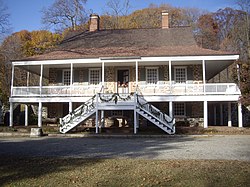Van Cortlandt Manor
|
Van Cortlandt Manor
|
|
 |
|
| Location | Croton-on-Hudson, NY |
|---|---|
| Coordinates | 41°11′30″N 73°52′35″W / 41.19167°N 73.87639°WCoordinates: 41°11′30″N 73°52′35″W / 41.19167°N 73.87639°W |
| Built | 1665 |
| Architectural style | Dutch-English Colonial |
| NRHP Reference # | 66000579 |
| Significant dates | |
| Added to NRHP | October 15, 1966 |
| Designated NHL | November 5, 1961 |
Van Cortlandt Manor is a house and property located by the confluence of the Croton and Hudson Rivers located in the village of Croton-on-Hudson in Westchester County, New York, United States. The stone and brick manor house is now a National Historic Landmark. It is on South Riverside Avenue.
By Royal Charter, Van Cortlandt Manor was a originally a 86,000-acre (35,000 ha) tract granted as a Patent to Stephanus Van Cortlandt in 1697 by King William III, stretching from the Hudson River on the west to the first boundary line between the Province of New York and the Colony of Connecticut, on the east, twenty English miles in length by ten in width, in shape nearly a rectangular parallelogram, forming, “The Manor of Cortlandt.” The massive holding was acquired by direct purchase from the Indians, in part, by Stephanus van Cortlandt, a native born Dutch gentleman of New York, and in part by others whose titles he subsequently bought, this tract, together with a small tract on the west side of the Hudson River opposite the promontory of Anthony’s Nose, which he also purchased from the Indians.
The Manor House was built sometime before 1732 but was not any owner's principal residence until a grandson, Pierre Van Cortlandt, moved there in 1749. At that time the manor house was on a 1,000-acre (405 ha) portion of the original tract.
Pierre brought his family to the estate in 1749 and established the manor into its most vibrant days, according to some. During this period, the manor was operating an apple orchard, dairy farm, a bee house, a kiln, a tavern, and carpenter and blacksmith shops. Van Cortlandt Manor was a self-sustaining community while Pierre and his family resided in the estate. At this time, though, tensions leading to the Revolutionary War were building and the manor would become a place of wartime retreat.Pierre sided with the colonies and the manor was used to assist the Continental Army, using its resources to make food and supplies. Pierre was involved with military legislature, and his son Philip was a soldier for the Continental Army. Eventually Pierre and his family vacated the manor in the thick of the war. The manor was ransacked by the British Army and left in poor standing. Philip, becoming a brigadier general by the war’s end, returned and, along with his sister, Catherine, brought the manor back to working order.
...
Wikipedia


